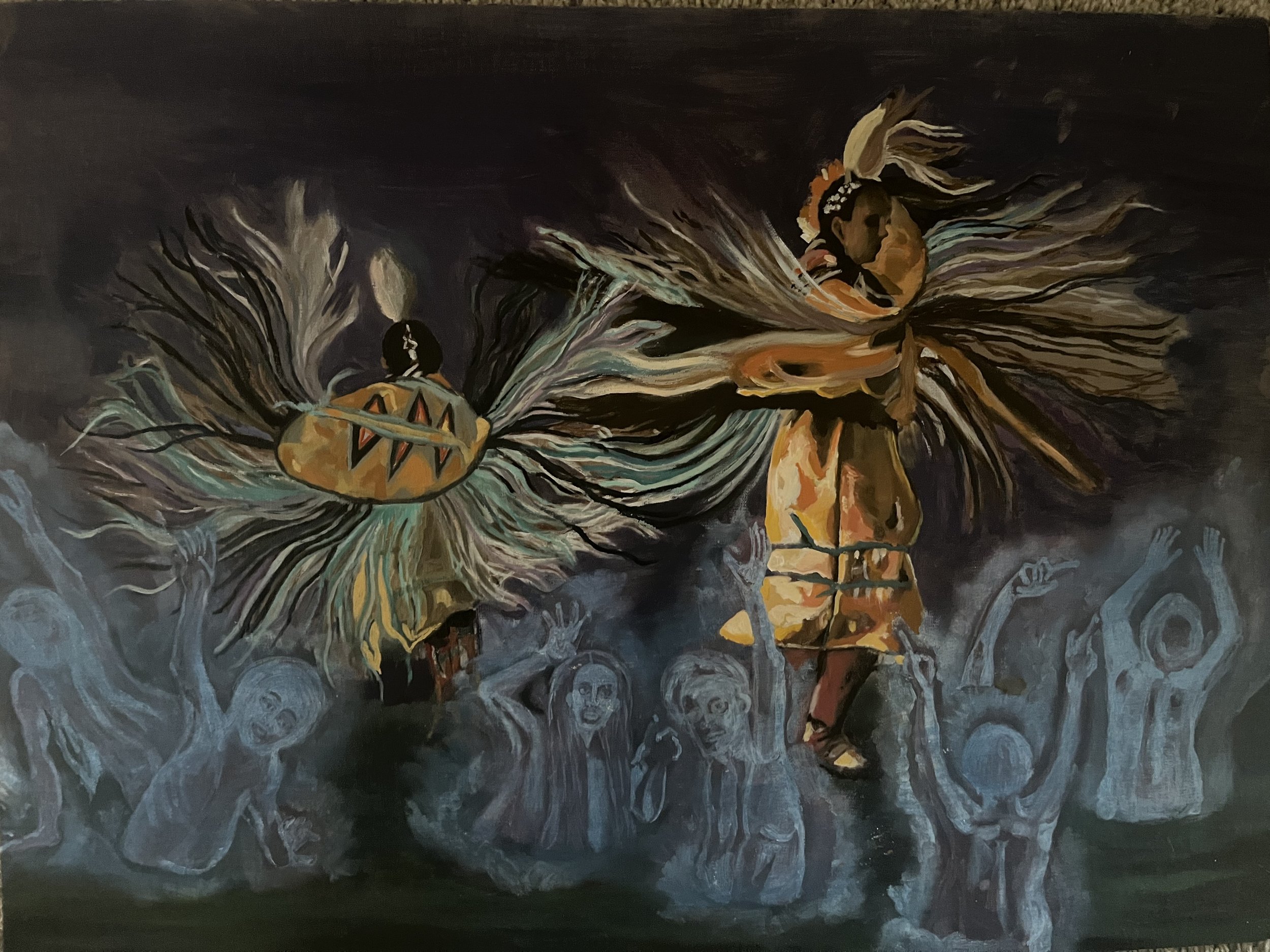Ushering Peace for Wounded Souls
Sarah Kushwara
“My work is sometimes said to be quite dark, and it’s nothing I can help because I paint the truth.”
Interview by C. VanWinkle
November 26, 2021
Hi Sarah. What did you respond to?
Well, I had a musical prompt. It sounded electronic and I’m not familiar with electronic music that much. It sounded a little to me like Kraftwerk. It was rather dark, and it evoked something primitive within me.
Do you remember your first impression when you heard it?
“This is intense!” I listened to it and said, “Whoa, this is intense!” I put it on the back burner and then I listened to it a few days later in its entirety before I began the painting. And I listened to it a few times throughout painting process, too. Not the entire time I was painting. [laughs] I couldn’t do that with any song!
But you revisited it often.
Yes.
What kind of stuff did it make you think of? What happened next?
It made me feel, not really think. Yeah. It was rather dark to me. It evoked some anxiety. But it was something that I wanted to keep listening to and not shut off.
I see. How did you get started with your painting?
Well, I’m also a photographer, as well as a painter. I took my family to a Native American corn festival in Washington, CT, an annual event held by The Institute for American Indian Studies, and I took pictures of the dancers. My pictures always inspire my work. Movement and dancing inspire my work. And I wanted to do something using a photo reference of these dancers in motion, so this was perfect for this project.
Do you usually depict motion in your work?
Yes, I do it all the time. It’s something I’d like to include in every piece of mine in the future.
Ushering Peace For Wounded Souls in progress
And you often work with dancing as a motif?
Yes! I’ve worked with flamenco, native Bolivian dancing, Native American dancing, Irish step dancing... I really want to include ballet, dervishes, and maybe The Bengali Bauls in upcoming pieces. Dancing is such a powerful action, and it moves me to tears quite often.
How else does this piece relate to the rest of your work?
I’m using a technique in this painting, called the Mische technique. I used it for the ghosts coming through the ground that are evoked by the dancers. It’s a layering technique. You can use egg tempera or casein to make the optical whites, layering the optical whites in between layers of glazing, so it creates this ethereal or perhaps ghostly illusion in the work. Although I direct paint quite a bit, I have been incorporating this indirect way of painting into my work.
It’s a cool effect!
Thank you. My work is sometimes said to be quite dark, and it’s nothing I can help because I paint the truth.
Oh yes, the truth is frequently dark. Does your work, both your photography and your painting, always tell a story? You appear to be telling one here.
Most of the time, yes. The painting reveals a story to me and sometimes my subconscious thoughts come through the painting. In this case, I was reflecting on ancestral relations, particularly in Native American cultures. I don’t want to be too specific, though. I would like the audience to decide for themselves what is happening in my painting, what energy and messages I am channeling.
That’s cool. Do you yourself have a relationship with Indigenous cultures?
I am not Native, but I have profound respect as well as interest in their cultures. A few years ago, I saw an extraordinary musician perform. She had Native roots and used throat singing, but she did it in a non-traditional way. Her name is Tanya Tagaq, and her performances are incredibly inspiring. You should check her out! I have a thing for that sort of overtone singing, whether it be Tuvan, Inuit, traditional, experimental.
[Editor’s note: I looked up Tanya Tagaq and watched her TED Talk. It’s absolutely fascinating. It’s on the internet; you know what to do.]
Do you know which nation you were taking pictures of dancing at that corn festival?
Not these particular dancers, no. There were a plethora of Native tribes from the area there. I know the Mohawks are from the area, and the Mashantucket Pequot.
How do you feel about collaboration? Do you enjoy it? Is it difficult?
Sometimes it’s quite difficult for me. I do enjoy it, but it’s quite challenging to me. It depends. Even if you pick the artist that you collaborate with, you may work completely differently. So I find it quite challenging, but it’s something I’d like to do more of in the future. I have collaborated with musicians before and that has gone well. I find that a relationship that works well with my art is with dancers and musicians.
Then it sounds like you got the right prompt!
Yes, but like I said, it was also challenging because I really don’t listen to electronic music on my own. I don’t know much about it.
I think someone looking at your painting could assume that electronic music is probably not what they’re dancing to.
Correct.
Were you very concerned with sticking close to the source material or doing something very different? How did you feel about that aspect?
It was challenging to me. I made sure to replay the song from time to time during the painting. Of course, I played other music in between because this painting wasn’t made overnight.
Oh sure. Anyone participating in this project has to feel out how far they want to wander off. There’s no wrong answer there, but you have to figure that out in your process.
And actually, in a way it’s still not finished. I have more work to do on it, and when it’s finished, it will be a map for a much larger painting aimed to capture movement and spirit.
Wow, that sounds ambitious. What is your advice for someone else who might participate in this project?
Do it! Do it! Collaboration is great practice on both ends and every connection you make should inspire you in some sort of way.
Call Number: C61MU | C63VA.kuUshe
Sarah Kushwara is Connecticut-based painter and photographer. She lives beyond time and listens to old Jazz and Blues records with her son and husband.




